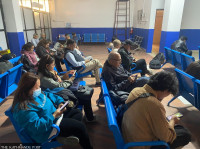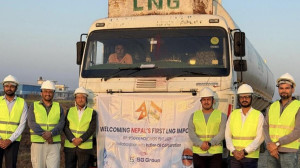Money
After a decade of struggle, Kabeli Corridor finally gets full shape
The energy slated to be produced by many private projects in the region will not go to waste now for lack of transmission infrastructure..jpg&w=900&height=601)
Prahlad Rijal
Project officials are all set to begin commercial operation of the Kabeli corridor power lines nearly a decade after construction began on what is touted as the backbone of the power distribution system in eastern Nepal.
Upon completion of the third section of the power lines recently, buoyed officials say that the transmission cables can now evacuate over 200 MW of power generated by a slew of private projects to the national grid in the upcoming months.
“We have fully revived a chronic national-priority project mired by obstructions, land compensation and forest clearance issues and contractor’s dilly-dallying,” said Deependra Raj Dwivedi, project chief. “At present, we are testing the infrastructure and we will begin commercial operation within four to five days.”
After completing the third and final portion of the corridor, officials are currently testing the structure by adding around 50 MW of electricity generated by Iwa Khola hydel scheme and Kabeli A hydroelectric project in Panchthar district.
According to Dwivedi, 170 MW will be added to the grid through the 91-km-long power lines in the corridor once commercial operations begin and more power will be conveyed once other under-construction plants such as Kabeli B1 are complete.
The project has erected 261 pylons to evacuate power from schemes concentrated at Kabeli, Hewa and Mai rivers in Panchthar and Taplejung districts.
Initially, the state-owned power utility had planned to bring the final section of the 132 kV power lines online by the second week of July but a brief hiatus owing to a tussle between project officials and the contractor differed the power utility’s plan.
The first 35-km-stretch extending from Lakhanpur to Godak had come into operation four years ago and the second Soyak-Phidim section went online this year in May relaying 14.9 MW of electricity produced by Hewa Khola A and 22 MW Lower Hewa Khola schemes.
In the absence of infrastructure, the power developers had been complaining of losses amounting to Rs 200 million caused by spillage of power.
“We were finally able to complete the troubled project after frequent deliberations with and support from local level authorities,” said Kulman Ghising, managing director at the Nepal Electricity Authority. “Now the energy slated to be produced by many private projects in the region will not go to waste for lack of transmission infrastructure.
The power utility has also completed the construction of 132-33-11 kV substations in Damak, Godak and Thapatar.
Earlier, works have come to a halt over obstructions from locals of Illam and Phidim who had demanded 100 percent of land compensation to give up the easement rights and rerouting of the power infrastructure in few forest areas.
As per the prevailing laws, the power utility cannot pay more than 10 percent compensation for 9 metres of land on each side of the transmission line.
The law states that 100 percent compensation will be paid for the land where the tower is built and 10 percent compensation for right of way on land over which the transmission line passes.
Also, the project had faced difficulties in receiving tree cutting permits from the authorities as the power lines passed through the protected forest area.
The $31 million project was executed with investments from the power utility, government and a concessional loan from the World Bank.
However, after the project which began in 2011 and was expected to be completed by 2013 missed multiple deadlines the multilateral lender had pulled out from the project in 2017.
***
What do you think?
Dear reader, we’d like to hear from you. We regularly publish letters to the editor on contemporary issues or direct responses to something the Post has recently published. Please send your letters to [email protected] with "Letter to the Editor" in the subject line. Please include your name, location, and a contact address so one of our editors can reach out to you.




 11.12°C Kathmandu
11.12°C Kathmandu















